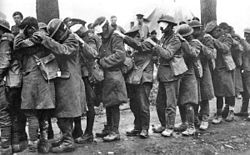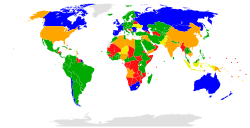1925 Geneva Protocol
The Geneva Protocol of 1925 (The Protocol for the Prohibition of the Use in War of Asphyxiating, Poisonous or Other Gases, and of Bacteriological Methods of Warfare)[1] was a law that made it illegal to fight with chemical or biological weapons in interstate war. The Geneva protocol was signed on June 17, 1925[2] and the protocol was entered into force on January 8, 1928.[3] Before, it was signed by some countries like the United Kingdom and France originally. Any country who has signed this Protocol must follow it.
After World War I, the Geneva Protocol was made from the treaties signed with Austria, Hungary and Bulgaria. The use of chemical weapons began in WWI when one million deaths resulted from chemical weapons.
After signing the treaty, some countries wanted to change it so that they would not have to follow it if the country fighting them did not follow the treaty. Because of this, many countries like France and United Kingdom withdrew from it. Others, like the United States still follow it but with this extra condition.
1925 Geneva Protocol Media
British troops blinded by poison gas during the Battle of Estaires, 1918
Rabbit used to check for leaks at a sarin production plant in 1970
References
- ↑ "Geneva Gas Protocol". Encyclopedia Britannica.
- ↑ "Treaties, States parties, and Commentaries - Geneva Protocol on Asphyxiating or Poisonous Gases, and of Bacteriological Methods, 1925". ihl-databases.icrc.org. Retrieved 2018-03-13.
- ↑ "Geneva Protocol" (in en-US). U.S. Department of State. https://www.state.gov/t/isn/4784.htm. Retrieved 2018-03-13.
- "Primary Documents- Geneva Protocol, 17 June 1925." firstworldwar.com. First World War.com, 22 Aug. 2009. Web. 6 Dec. 2011.
- "1925 Geneva Protocol." un.org. UNODA: United Nations Office for Disarmament Affairs, n.d. Web. 6 Dec. 2011.
- "Geneva Protocol." fas.org. FAS: Weapons of Mass Destruction, n.d. Web. 6 Dec. 2011.


